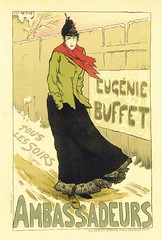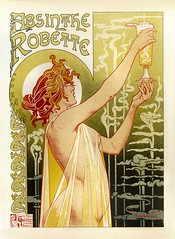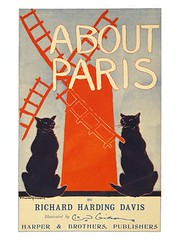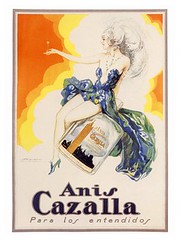
Thursday 8 April 2010
Friday 19 March 2010
Saturday 6 March 2010
Wednesday 3 March 2010
Art and literature
Art and literature
The last ball, 1905. Aurélio de Figueiredo.The arts underwent a radical transformation during the decades before World War I, and new artistic forms associated with cultural modernity emerged.
Impressionism, which had been considered the artistic avant-garde in the 1860s, did not gain widespread acceptance until after World War I: the academic realist painting style that appealed to the Belle Époque is exemplified in the eroticism paraded as mythology of William-Adolphe Bouguereau or John William Waterhouse, or the idyllic Roman scenes of Lord Leighton. More progressive tastes patronized the Barbizon school plein-air painters, and in Britain, the Pre-Raphaelites, who inspired a generation of esthetic-minded "Souls". The largely decorative style known as Art Nouveau (Jugendstil in central Europe), characterized by its curvilinear forms, become prominent from the mid-90s and dominated progressive design throughout much of Europe. Many successful examples of this style, with notable regional variations, were built in France, Germany, Belgium, Spain, Austria (the Vienna Secession), Hungary, Bohemia and Latvia. It soon spread around the world, including to Mexico and the United States.
Theatre adopted new modern methods, including Expressionism, and many playwrights wrote plays that shocked contemporary audiences either with their frank depictions of everyday life and sexuality or with unusual artistic elements. Cabaret theater also became popular. Musically, the Belle Époque was characterized by salon music. This was not considered "serious" music but, rather, short pieces considered accessible to a general audience. In addition to works for piano solo or violin and piano, the Belle Époque was famous for its large repertory of songs (mélodies, romanze, etc.). The Italians were the greatest proponents of this type of song, its greatest champion being Francesco Paolo Tosti. Though Tosti's songs never completely left the repertoire, salon music generally fell into a period of obscurity. Even as encores, singers were afraid to sing them at "serious" recitals. In that period, waltzes also flourished. Operettas were also at the peak of their popularity, with composers such as Johann Strauss III, Emmerich Kalman, and Franz Lehár. It was during this era that the motion pictures were developed, though these did not become common until after World War I.
European literature underwent a major transformation during the Belle Époque. Literary realism and naturalism achieved new heights. Among the most famous realist or naturalist authors are Benito Pérez Galdós, Theodor Fontane, Guy de Maupassant and Émile Zola. Realism gradually developed into modernism, which emerged in the 1890s and came to dominate European literature during the Belle Époque's final years and throughout the interwar years. Among the most prominent European modernist authors are Andrei Bely, Joseph Conrad, James Joyce, Franz Kafka, D. H. Lawrence, Thomas Mann, Robert Musil, Marcel Proust, Arthur Schnitzler, Robert Walser and William Butler Yeats.
The last ball, 1905. Aurélio de Figueiredo.The arts underwent a radical transformation during the decades before World War I, and new artistic forms associated with cultural modernity emerged.
Impressionism, which had been considered the artistic avant-garde in the 1860s, did not gain widespread acceptance until after World War I: the academic realist painting style that appealed to the Belle Époque is exemplified in the eroticism paraded as mythology of William-Adolphe Bouguereau or John William Waterhouse, or the idyllic Roman scenes of Lord Leighton. More progressive tastes patronized the Barbizon school plein-air painters, and in Britain, the Pre-Raphaelites, who inspired a generation of esthetic-minded "Souls". The largely decorative style known as Art Nouveau (Jugendstil in central Europe), characterized by its curvilinear forms, become prominent from the mid-90s and dominated progressive design throughout much of Europe. Many successful examples of this style, with notable regional variations, were built in France, Germany, Belgium, Spain, Austria (the Vienna Secession), Hungary, Bohemia and Latvia. It soon spread around the world, including to Mexico and the United States.
Theatre adopted new modern methods, including Expressionism, and many playwrights wrote plays that shocked contemporary audiences either with their frank depictions of everyday life and sexuality or with unusual artistic elements. Cabaret theater also became popular. Musically, the Belle Époque was characterized by salon music. This was not considered "serious" music but, rather, short pieces considered accessible to a general audience. In addition to works for piano solo or violin and piano, the Belle Époque was famous for its large repertory of songs (mélodies, romanze, etc.). The Italians were the greatest proponents of this type of song, its greatest champion being Francesco Paolo Tosti. Though Tosti's songs never completely left the repertoire, salon music generally fell into a period of obscurity. Even as encores, singers were afraid to sing them at "serious" recitals. In that period, waltzes also flourished. Operettas were also at the peak of their popularity, with composers such as Johann Strauss III, Emmerich Kalman, and Franz Lehár. It was during this era that the motion pictures were developed, though these did not become common until after World War I.
European literature underwent a major transformation during the Belle Époque. Literary realism and naturalism achieved new heights. Among the most famous realist or naturalist authors are Benito Pérez Galdós, Theodor Fontane, Guy de Maupassant and Émile Zola. Realism gradually developed into modernism, which emerged in the 1890s and came to dominate European literature during the Belle Époque's final years and throughout the interwar years. Among the most prominent European modernist authors are Andrei Bely, Joseph Conrad, James Joyce, Franz Kafka, D. H. Lawrence, Thomas Mann, Robert Musil, Marcel Proust, Arthur Schnitzler, Robert Walser and William Butler Yeats.
Science and technology
Science and technology
The Belle Époque was an era of great scientific and technological advancement in Europe and the world in general. Inventions that either are associated with this era or became generally common in this era include the perfection of lightly-sprung, noiseless carriages in a multitude of new fashionable forms, which were superseded towards the end of the era by the automobile, which was for its first decade a luxurious experiment for the well-heeled, The telephone joined the telegraph as a vehicle for rapid communication, and electric light began to supersede gas lighting. The phonograph and the cinématographe were embraced, though the aeroplane remained a fascinating experiment.
It was during this era that biologists and physicians finally came to understand the germ theory of disease, and the field of bacteriology was established. Max Planck, Albert Einstein, Nikola Tesla and Niels Bohr initiated modern physics. To recognize many of the great advances made in science in this era, the Nobel Prizes were established for physics, chemistry, and physiology or medicine.
The social sciences also flourished with the professionalization and modernization of research techniques for many disciplines, including history and political science. Georg Simmel, Émile Durkheim and Max Weber, along with American Thorstein Veblen, pioneered the field of academic sociology.
The Belle Époque was an era of great scientific and technological advancement in Europe and the world in general. Inventions that either are associated with this era or became generally common in this era include the perfection of lightly-sprung, noiseless carriages in a multitude of new fashionable forms, which were superseded towards the end of the era by the automobile, which was for its first decade a luxurious experiment for the well-heeled, The telephone joined the telegraph as a vehicle for rapid communication, and electric light began to supersede gas lighting. The phonograph and the cinématographe were embraced, though the aeroplane remained a fascinating experiment.
It was during this era that biologists and physicians finally came to understand the germ theory of disease, and the field of bacteriology was established. Max Planck, Albert Einstein, Nikola Tesla and Niels Bohr initiated modern physics. To recognize many of the great advances made in science in this era, the Nobel Prizes were established for physics, chemistry, and physiology or medicine.
The social sciences also flourished with the professionalization and modernization of research techniques for many disciplines, including history and political science. Georg Simmel, Émile Durkheim and Max Weber, along with American Thorstein Veblen, pioneered the field of academic sociology.
The Belle Époque floated on a class structure
The Belle Époque floated on a class structure that ensured cheap labour. The underground railway joined the omnibus and streetcar in transporting the working population, including those servants who did not live in; one result was that working-class and upper-class neighbourhoods might be separated by large distances.
The years between the Franco-Prussian War (1870-71) and World War I (1914-18) were characterized by unusual political stability in western and central Europe. Although tensions between the French and German governments persisted as a result of the French loss of Alsace-Lorraine to Germany during 1871, diplomatic conferences, including the Congress of Berlin in 1878 and the Berlin Congo Conference in 1884, mediated disputes that threatened the general European peace. Indeed, for many Europeans, transnational, class-based affiliations were as important as national identities in the Belle Époque. A middle- or upper-class gentleman could travel through much of Europe without a passport and even reside abroad with minimal bureaucratic regulation. Meanwhile, the international workers' movement also reorganized itself and reinforced pan-European, class-based identities among the classes whose labour supported the Belle Époque. The most notable transnational socialist organization was the Second International.
In terms of domestic politics, there were very few regime changes in Europe, the major exception being Portugal, which experienced a republican revolution in 1910. However, tensions between working-class socialist parties, bourgeois liberal parties, and landed or aristocratic conservative parties did increase in many countries; and it has been claimed that profound political instability belied the calm surface of European politics in the era. In fact, militarism and international tensions grew considerably between 1897 and 1914, and the immediate prewar years were marked by a general armaments competition in Europe. Additionally, this era was one of massive overseas colonialism, known as the New Imperialism, or High Imperialism. The most famous portion of this imperial expansion was the Scramble for Africa.
The years between the Franco-Prussian War (1870-71) and World War I (1914-18) were characterized by unusual political stability in western and central Europe. Although tensions between the French and German governments persisted as a result of the French loss of Alsace-Lorraine to Germany during 1871, diplomatic conferences, including the Congress of Berlin in 1878 and the Berlin Congo Conference in 1884, mediated disputes that threatened the general European peace. Indeed, for many Europeans, transnational, class-based affiliations were as important as national identities in the Belle Époque. A middle- or upper-class gentleman could travel through much of Europe without a passport and even reside abroad with minimal bureaucratic regulation. Meanwhile, the international workers' movement also reorganized itself and reinforced pan-European, class-based identities among the classes whose labour supported the Belle Époque. The most notable transnational socialist organization was the Second International.
In terms of domestic politics, there were very few regime changes in Europe, the major exception being Portugal, which experienced a republican revolution in 1910. However, tensions between working-class socialist parties, bourgeois liberal parties, and landed or aristocratic conservative parties did increase in many countries; and it has been claimed that profound political instability belied the calm surface of European politics in the era. In fact, militarism and international tensions grew considerably between 1897 and 1914, and the immediate prewar years were marked by a general armaments competition in Europe. Additionally, this era was one of massive overseas colonialism, known as the New Imperialism, or High Imperialism. The most famous portion of this imperial expansion was the Scramble for Africa.
The Belle Époque
The Belle Époque (French pronunciation: [bɛlepɔk]; French for "Beautiful Era") was a period in European social history that began during the late 19th century and lasted until World War I. Occurring during the time of the French Third Republic and the German Empire, the "Belle Époque" was named in retrospect, when it began to be considered a "golden age" for the upper classes, as peace prevailed among the major powers of Europe, new technologies improved upper-class lives that were unclouded by income tax, and the commercial arts adapted Renaissance and eighteenth-century styles to modern forms. In the newly rich United States, emerging from the Panic of 1873, the comparable epoch was dubbed the "Gilded" (not Golden) Age. In Great Britain, this epoch overlaps the end of what is called the Victorian Era there and the period named the Edwardian Era.
The separation between the fortunes and daily life of "haves" and "have nots" in Western Europe and the United States increased dramatically in the last quarter of the century. Cheap coal and cheap labour contributed to the cult of the orchid[2] and made possible the perfection of fruits grown under glass, as the apparatus of state dinners extended to the upper classes; champagne was perfected during the Belle Époque. Exotic feathers and furs were more prominently featured in fashion than ever before, as haute couture was invented in Paris, the centre of the Belle Époque, where fashion began to move in a yearly cycle; in Paris restaurants such as Maxim's achieved a new splendour and cachet as places for the rich to parade, and the Opéra Garnier devoted enormous spaces to staircases as similar show places. After mid-century railroads linked all the major cities of Europe to spa towns like Biarritz and Deauville; their carriages were rigorously divided into first-class and second-class, but the super-rich now began to commission private railroad cars, as exclusivity was a hallmark of opulent luxury. Bohemian lifestyles gained a different glamour, pursued in the cabarets of Montmartre.
The separation between the fortunes and daily life of "haves" and "have nots" in Western Europe and the United States increased dramatically in the last quarter of the century. Cheap coal and cheap labour contributed to the cult of the orchid[2] and made possible the perfection of fruits grown under glass, as the apparatus of state dinners extended to the upper classes; champagne was perfected during the Belle Époque. Exotic feathers and furs were more prominently featured in fashion than ever before, as haute couture was invented in Paris, the centre of the Belle Époque, where fashion began to move in a yearly cycle; in Paris restaurants such as Maxim's achieved a new splendour and cachet as places for the rich to parade, and the Opéra Garnier devoted enormous spaces to staircases as similar show places. After mid-century railroads linked all the major cities of Europe to spa towns like Biarritz and Deauville; their carriages were rigorously divided into first-class and second-class, but the super-rich now began to commission private railroad cars, as exclusivity was a hallmark of opulent luxury. Bohemian lifestyles gained a different glamour, pursued in the cabarets of Montmartre.
Subscribe to:
Posts (Atom)









